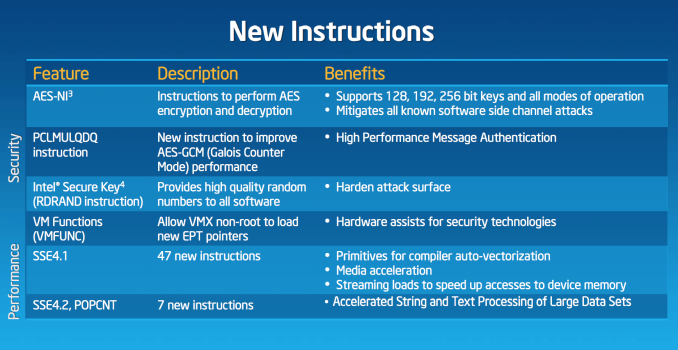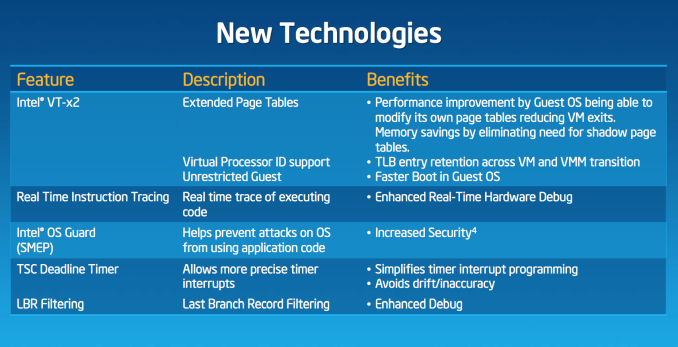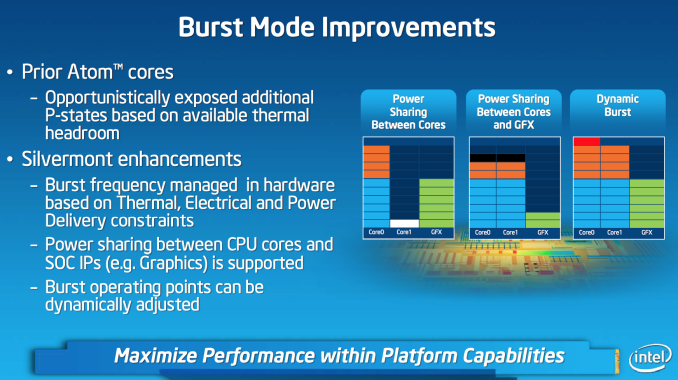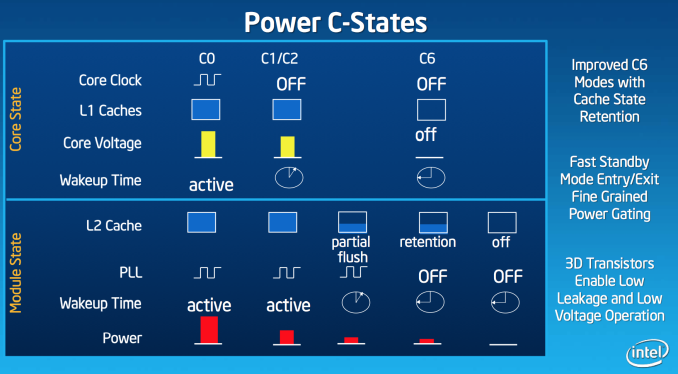Intel’s Silvermont Architecture Revealed: Getting Serious About Mobile
by Anand Lal Shimpi on May 6, 2013 1:00 PM EST- Posted in
- CPUs
- Intel
- Silvermont
- SoCs
ISA
The original Atom processor enabled support for Merom/Conroe-class x86 instructions, it lacked SSE4 support due to die/power constraints; that was at 45nm, at 22nm there’s room for improvement. Silvermont brings ISA compatibility up to Westmere levels (Intel’s 2010 Core microprocessor architecture). There’s now support for SSE4.1, SSE4.2, POPCNT and AES-NI.
Silvermont is 64-bit capable, although it is up to Intel to enable 64-bit support on various SKUs similar to what we’ve seen with Atom thus far.
IPC and Frequency
The combination of everything Intel is doing on the IPC front give it, according to Intel, roughly the same single threaded performance as ARM’s Cortex A15. We’ve already established that the Cortex A15 is quite good, but here’s where Silvermont has a chance to pull ahead. We already established that Intel’s 22nm process can give it anywhere from a 18 - 37% performance uplift at the same power consumption. IPC scaling gives Silvermont stable footing, but the ability to run at considerably higher frequencies without drawing more power is what puts it over the top.
Intel isn’t talking about frequencies at this point, but I’ve heard numbers around 2 - 2.4GHz thrown around a lot. Compared to the 1.6 - 2GHz range we currently have with Bonnell based silicon, you can see how the performance story gets serious quickly. Intel is talking about a 50% improvement in IPC at the core, combine that with a 30% improvement in frequency without any power impact and you’re now at 83% better performance potentially with no power penalty. There are other advantages at the SoC level that once factored in drive things even further.
Real Turbo Modes & Power Management
Previous Atom based mobile SoCs had a very crude version of Intel’s Turbo Boost. The CPU would expose all of its available P-states to the OS and as it became thermally limited, Intel would clamp the max P-state it would expose to the OS. Everything was OS-driven and previous designs weren’t able to capitalize on unused thermal budget elsewhere in the SoC to drive up frequency in active parts of chip. This lack of flexibility even impacted the SoC at the CPU core level. When running a single threaded app, Medfield/Clover Trail/et al couldn’t take thermal budget freed up by the idle core and use it to drive the frequency of the active core. Previous Atom implementations were basically somewhere in the pre-Nehalem era of thermal/boost management. From what I’ve seen, this is also how a lot of the present day ARM architectures work as well. At best, they vary what operating states they expose to the OS and clamp max frequency depending on thermals. To the best of my knowledge, none of the SoC vendors today actively implement modern big-core-Intel-like frequency management. Silvermont fixes this.
Silvermont, like Nehalem and the architectures that followed, gets its own power control unit that monitors thermals and handles dynamic allocation of power budget to various blocks within the SoC. If I understand this correctly, Silvermont should expose a maximum base frequency to the OS but depending on instruction mix and available TDP it can turbo up beyond that maximum frequency as long as it doesn’t exceed TDP. Like Sandy Bridge, Silvermont will even be able to exceed TDP for a short period of time if the package temperature is low enough to allow it. Finally, Silvermont’s turbo can also work across IP blocks: power budget allocated to the GPU can be transferred to the CPU cores (and vice versa).
By big-core standards (especially compared to Haswell), Silvermont’s turbo isn’t all that impressive but compared to how things are currently handled in the mobile space this should be a huge step forward.
On the power management side, getting in and out of C6 should be a bit quicker. There's also a new C6 mode with cache state retention.















174 Comments
View All Comments
Amoro - Monday, May 6, 2013 - link
In the first sentence of the paragraph below the Saltwell Vs. Silvermont graph, it states "In terms of absolute performance, Saltwell’s peak single threaded performance is 2x that of Saltwell" and it should be "Silvermont's peak single...."ClockworkPirate - Monday, May 6, 2013 - link
Also at the end of the first paragraph on the "Tablet Expectations and Performance" page, "...with Haswell picking up above Haswell." should probably be "...with Haswell picking up above Bay Trail."chrone - Monday, May 6, 2013 - link
this is the soc i've been waiting for since 2008. winter is coming!! it's gonna be a long winter for arm and friends ahead. \m/theos83 - Monday, May 6, 2013 - link
lol...wait and watch...it has been a long winter for intel (from a mobile market point of view), lets see what they end up with in the next 4 years...ARM and friends are not going away anytime soon.Hector2 - Friday, May 17, 2013 - link
True. The difference between then and now is that Intel didn't have an SoC designed and optimized for smartphones. Now they do (this year) and it'll be about 22nm & 14nm offering Intel higher performance, lower power and lower cost. In this area Intel has about a 2 year lead on their competitionKrysto - Monday, May 6, 2013 - link
It's very, very, VERY hard to beat a monopoly in a certain market (ARM that is), even with a company like Intel that may have a monopoly in another.Plus they have like a dozen competitors there, with at least 3-4 top ones. Intel has promised a lot of stuff before, and under-delivered. So we'll see. ARM chips are also going 20nm and 64 bit next year, and at 14nm FinFET the year after that (yes, only a year later).
Plus, if these things cost 2-3x what the high-end ARM chips cost, they can just pack and go home. No OEM will accept that, unless Intel gives them Haswell in PC's for 30% off, or some deal like that (which would mean they won't be making any money on these Atoms anytime soon).
klmccaughey - Tuesday, May 7, 2013 - link
Intel has the cash to loss-lead on this and open a big crack into the market. It also has the bucks to advertise.My guess is that shareholders are screaming for Intel to get into this market. All the omens look good and I am really looking forward to a big jump in power and battery life for mobiles. I think ARM finally has a real competitor.
HisDivineOrder - Tuesday, May 7, 2013 - link
Intel (and MS) are still under the delusion they're in the 1990's where they could be a premium vendor. Look at all the Windows tablets for proof of this. Intel and MS are both charging way more than they should and all their Wintel tablets (RT or 8) are overpriced by a huge amount.Intel doesn't loss lead. At least, they haven't shown any sign of it at all. Maybe this will be their moment, but somehow... I really, really doubt it.
zeo - Wednesday, May 8, 2013 - link
Don't confuse Intel with the OEMs and MS, Intel isn't over charging on their hardware!The listed Tray cost for the Clover Trail Z2760 SoC is only $41, at a time when ARM high end SoCs are starting to go over $30... So there's not a multiple times cost difference anymore.
OEMs just mistakenly took their cue from MS pricing of the Surface and it's not like the tablet market is really set up for PC configurations.
OEMs for example are used to using internal drive capacity as a way of charging more of their products. Like it doesn't cost anywhere near $50 to double the drive capacity of a Nexus 7 for example or how Apple charges a $100 for each doubling of capacity.
Remember, Windows tablets start with 32GB and that's much higher minimum than what mobile devices still offer.
Along with inclusion of full size USB ports, the added cost of Windows license, the greater tendency to include premium parts like WACOM digitizers, etc all added together for how the pricing finally came out...
However, the OEMs should have learned their lessons, MS is definitely going to offer them better volume license fees this time around, and Bay Trail is suppose to be even lower priced than Clover Trail... So we should see much better pricing with this new generation of products.
BSMonitor - Wednesday, May 8, 2013 - link
Its not a monopoly. There are several companies that build ARM SoC's. ARM is an ISA, no different than x86. If Intel delivers quantity, better performaning SoC's than the competitors, best believe they will switch. Apple already does x86 in house on OS X. Promise you they have been testing Atom in house for potential future designs.. Whether those designs win over ARM A# in house designs is another matter... Intel is nothing if not good at getting companies to sign up with them.. They deliver the highest quality and highest quantities of anyone in the silicon business.